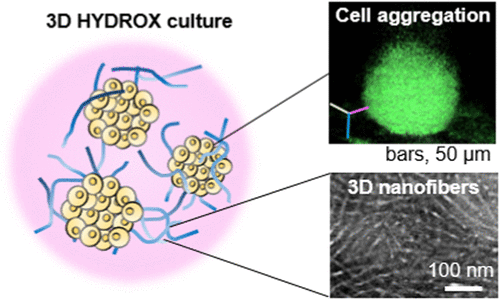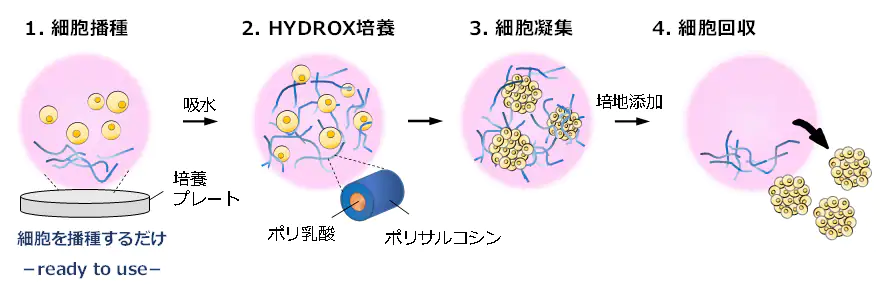

SHIMADZU: Achieves three-dimensional culture of cells: Easy and safe
-Providing 3D nanofiber “HYDROX” outside the company-
Graduate School of Pharmaceutical Sciences, Osaka University
Shimadzu
In a joint research, it was applied to induce differentiation from human iPS cells to hepatocytes.
Realizes three-dimensional culture of cells.
We will provide 3D nanofiber HYDROX to research institutes and companies from January 2022 (Fig. 1).
Achieve three-dimensional culture of cells:
Our company
To support research institutes involved in cell research
We have promoted open innovation in the research and development of cell culture solutions.
Cell mass sample provided:
In cell research, drug discovery, regenerative medicine, etc.
It is required to construct a cell mass that is close to the function of the living body in vitro.
3D nanofiber “HYDROX”:
It is a new material originally developed by our company that assists the formation of cell clumps.
Department of Molecular Biology, Osaka University
Professor Hiroyuki Mizuguchi,
Yukiko Toba Specially Appointed Assistant Professor
In collaboration with the research group in August this year
We succeeded in “inducing differentiation of HYDROX from iPS cells to hepatocytes”.
Elucidated that it differentiates into hepatocytes with high efficiency (Reference 1)
Presented at the Molecular Biology Society:
About “HYDROX”
Announced at the Molecular Biology Society of Japan on December 1st,
We are planning to exhibit it at the Regenerative Medicine EXPO (Makuhari Messe) held on December 8th.
2021 | News | Shimadzu
https://www.shimadzu.co.jp/news/press/rwzo59_ut8znh8pf.html
Development of a 3D Cell Culture System Using Amphiphilic Polydepsipeptides and Its Application to Hepatic Differentiation
Abstract
Various three-dimensional (3D) culture systems
are available to provide more accurate in vivo mimicry than two-dimensional (2D) cultures.
Synthetic and/or xeno-free biomaterials are desired, as they would provide lower batch-to-batch variability and high repeatability.
Here,
we introduce a 3D culture system
using nanofibers composed of an amphiphilic polydepsipeptide-based polymer named HYDROX, which turns into 3D nanofibers after hydration.Our system produces a large amount of cell aggregates and requires only the seeding of a cell mixture.
In addition,
cells cultured with HYDROX
can be collected with only a centrifugation procedure, and analytical assays can then be performed.Here,
we applied HYDROX to hepatic differentiation from induced pluripotent stem cells.The cells cultured with HYDROX formed
aggregates and HYDROX strongly promoted hepatic differentiation and maturation in terms of functions
such as the positive ratio of
alpha-1 antitrypsin,
the production of albumin,
the cytochrome P450 (CYP) 3A4 activity, and the low-density-lipoprotein uptake ability.In addition,
primary human hepatocytes cultured with HYDROXshowed significantly improved CYP3A4 gene expression and activity.
The viscoelasticity and stiffness of HYDROX
can be modulated by varying the concentration of the synthetic polymer, thereby providing a suitable microenvironment for the differentiation of cells with various characteristics toward a target cell type.
Our findings demonstrated that
HYDROX is a promising biomaterial for 3D cultures in research fields ranging from basic cell research to drug discovery.ACS Applied Bio Materials